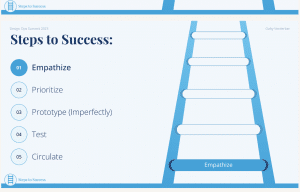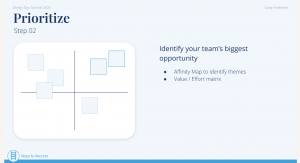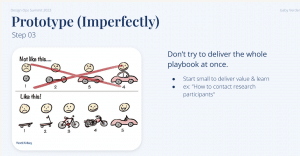Day 2-Documentation Your Team Will Actually Use

— Today’s topics is about documentation and what team will actually use, and will cover common pitfalls, what teams actually needs, process for documentation, delivering incremental value

— So I have a lot of things to say when we say docmentation
-
Two main types
-
The first is detailed processes and policies made by people managers or designops
-
How work done at organization
-
Playbooks, manuals, project templates
-
-

— The second of various projects
-
Why decisions made and researching findings

— We will focus on documenting process and policies, through the playbook artifact, but strategy is agnostic

— A playbook is a document to streamline process by having codified record of design practices, standards, and more
-
What is it made of?
— Typically organized in stages of work
-
Each stage matches org mental model
-
Plays will have relevant info like instructions template, and links on when used

— See example of playbook model created above
-
Can see org process like recruiting and analyzing and collecting data
-
Has clear navigation
-
Quick links
-
Next steps in process

— Zooming in to specific playbook, there is info on way to email participants and why this matters. Other items include:
-
Removing ineligible contacts from the link
-
Quick links for specific info
-
Explaining why info matters for users?
-
More detailed instructions later on

— Why do this?
-
Our teams do a lot, as average UXR toolkit has 13 tools and playbooks are useful to new hires and junior designers
-
Important for tenured designers as well
-
-
Unclear processes frustrating for all designers
-
26% of designers said no clear process was one of top 3 frustrations
-

— There are common pitfalls though:
-
I have a history of failed playbooks, with four playbooks, two toolkits,
-
At consultancy I had repeatable work with designer and driven crazy by asking same questions over
-
-
Documents were put into SharePoint, which only I could find
— I changed the info into a slide deck, but meant no way to distinguish between usable slides and explanatory slides
— Contributed to research manual, which had a lot of words and hard to digest
— Most recently moved to Coda Wikis, but there I had too many documents to know where to look for which content

— So here are the common pitfalls
-
In-actionable information
-
Difficult navigation
-
Cognitive overload
-
Outdated content

— Pitfall #1: Inactionable Information
-
Have you visited recipe blog which has block of text before the recipe?
-
This frustration is what to avoid for the design team
-
-
This principle took the longest for me to learn
-
People want info specific to org, and grasp what is needed, i.e. how to share wireframes
— To avoid this irrelevant wall of text, leave out generic content, and link to external resources

— Pitfall #2: If folks can’t find info, doesn’t matter how well it is written. Lack of findability can manifest in the following ways:
-
People can’t find the doc to begin with
-
The document structure that doesn’t match processes
-
There is limited search functionality
— You need to match navigation framework to the team mental model and make sure they know who the doc is written for

— Pitfall #3: Content can be overwhelming in the playbook
-
A lot to absorb prior to research
— Avoid
-
Walls of text
–Instead
-
Create visual hierarchy
-
Cut off the fluff

— Pitfall #4: Old information can erode trust and is no longer relevant
-
Poor info in one area will erode trust area as people will think playbook info is not relevant everywhere
— Review content on regular basis as it is important to keep info up to date to keep trust with team

— So let’s talk about moving ladder to success
-
Approach documentation as design problem

— Here’s a description of the process from the Interaction Design Foundation
-
Emphatize — Research user needs
-
Define– State problems
-
Ideate– Challenge assumptions
-
Prototype — Create incremental solutions
-
Test- Test solutions out

— The documentation would be slightly different as we would prioritize most important information and prototype with expectation of imperfection
-
There’s also the final step of circulating documentation

— The steps are presented in chronological order, but you might not follow it linearly and likely won’t do so at all

— So let’s empathize and grasp how team is currently getting info
-
Processes need to grasp reality of what it is
-
Don’t dicate process, especially if you are new to an org, and don’t deliver a playbook from ivory tower of DesignOps
-

— Grasp how people work and what they need help with
-
Ask ICs to walk through their documentation process in interviews
— Survey the team to grasp trends from interviews and a baseline for future metrics
-
Create confidence in process and satisfaction in documentation
— Have desk research to grasp existing usage of doc you currently have and review messaging channels like Slack or teams to understand what people are asking about most often
-
Can do this 100% on your own

— Prioritize and find biggest impact of documentation

— Your audience can be
-
Individual contributors and those who do the actual work
-
Audience as managers of teams
-
Stakeholders for what team does
— But assume IC as most common audience

— After empathy building, you should have good idea of what is needed
-
Need to focus on biggest pain points of team experience
— If ton of things to prioritize, use design facilitation schemes or putting things on value effort matrix to find the biggest priority

— Deliver small but complete sections and deliver value immediately

— I’ll leverage the analogy of incremental value for building a car
-
Using incremental approach to deliver value and lean delivery
-
Don’t hide to build perfect docs
-
-
Have small complete sections to team to get feedback and learn from it

— You don’t have to start from scratch
-
You can use CODA framework and few other resources to demo how people approached playbook
-
This needs to be actionable and match org needs and mental models
-
-
Inspiration, not a panacea

— Then test to make sure the solution meets process and mental models

— Have a pilot to refer people to documentation and ask about unanswered questions
— Have specific usability testing to complete with the playbook and one team
-
Observe team members and make adjustments based on pain points
-
Note: It’s a ton of fun to make these adjustments

— Finally encourage adoption through circulation

— 1. Share org channels, and refer folks to playbook when posssible
— 2. Set usage goal and track adoption (and learn why usage goal not being meant– no specific recommendation there, but important to measure)
— 3. Include documentation playbook in onboarding and training for accurate information and trainings

— You can then expand and document more things, and revisit what is the most valuable option
-
Playbooks are not static, and need to be continuously refreshed
-
Schedule reviews for outdated content
— Do quarterly reviews to keep content current

— A well designed playbook can clarify and define design practices with procedures
— Focus on
-
Actionable info
-
Support documentation to be easy to understand and navigate
-
Focus important info and cut fluff
-
Review doc on regular cadence and add new things as adopted

— Success
-
Empathize: How team is gettin info
-
Prioritize: Start with biggest pain points and biggest impact
-
Prototype (Imperfectly): Small but complete section, will delvier value sooner, and use templates
-
Test: Test doc to meet processe s and mental model
-
Circulate: Share completed page to meet adoption as much as possible

— Thank you, here’s info on sources I cited, and where to find me
FAQ
-
How to convert PDF playbooks for digital format?
-
Don’t necessarily have to ask, why teams are using PDF or InDesign format
-
-
Advice to balance documentation with fast updates from tools that require updates to function?
-
Ask yourself, are you creating a help document for the specific tool, or playbook for the org?
-
Tool probably has it’s own help documentation
-
Rely on stuff actual experts built out
-
-
-
Do you think should review Confluence regulary to make sure content updated? Should DesignOps be sole owner of Confluence space?
-
I like how product teams own their spaces within Confluences
-
Once a month feels pretty frequent to me. Cadence may make sense but ask what specifically you document and how often you update
-
-
How to track adoption? Any suggestions you have?
-
Whatever tool you use, it should track usage and views
-
Use whatever metrics are in the tool
-
-
Sneaky way is having people ask questions, and see if other non-doc team members link to the metric reference material
-
This runs the risk of vanity metrics, so be wary
-
-
-
The Coda tool has metrics? What are they?
-
See number of visitors and sessions, pages used most frequently
-
Also seeing which videos were wached most often
-
-
Basic adoption metrics, but stuff that could be helpful to start
-
-
How can adoption be shared collaboration and ownership for playbook?
-
Can totally be that, and can say individual contributors interested in DesignOps
-
At least 2-3 UX designers on my team who wrote up documentation process themselves
-
Shared ownership to reference more often
-
Documentation is not only group of people who care about process
-
-

